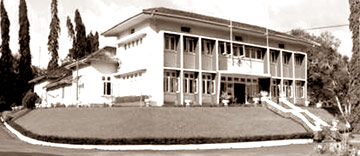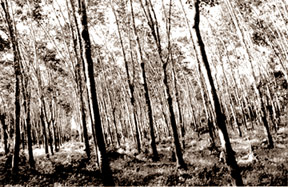RRI: Hundred years of excellence
Dr. L.M.K. Tillekeratne, Former Executive Director,
RRISL
|

Rubber Research Institute of Sri Lanka (RRISL),Agalawatta.
|
The Rubber Research Institute of Sri Lanka (RRISL) situated at
Agalawatta in the Kalutara District celebrates its 100 years of
excellence in research and also as the oldest rubber research institute
in the world.
The British explorer Henry Wickham, brought the first few rubber
plantlets planted in boxes from the Kew Garden in London, in 1876, and
they were planted in Gampaha Garden. There are records to say that a
part of these rubber plants were taken by him to Singapore as well and
planted there. But, there are no further reports to say as to what
happened to those plants and even evidence to say that the rubber
plantation in South East Asian countries was established from those
plantlets planted in Singapore. Hence, it is believed that the entire
rubber plantation in the whole of Asia, which is producing over 95% of
the world natural rubber need, was established from the plantlets
planted in Gampaha garden in 1876.
Research on rubber was initiated by British Planters in 1909 by
employing a chemist to study the coagulation process of latex , and this
activity has been renamed by them as the rubber replanting scheme in
1913, in order to pay more emphasis to the planting program both in Sri
lanka and in other South East Asian countries. Later, on the 13th
August, 1930, the Rubber Research Institute ordinance has been
incorporated and T.E.H. Obrien was appointed as its first director in
1932. The name "Rubber Research Institute" has been given to this rubber
research scheme in 1951, when its director was Dr E D C Baptist.
Yielding plants
The RRI established under the new name and even the Rubber Research
Scheme established in 1913 has been highly instrumental in researching
on agronomy to establish plantation in Sri Lanka as well as in other
Asian countries, by selecting best agro climatic conditions for rubber
plantation, methods of exploitation of latex without harming trees to
yield latex for not less than 15 to 20 years, fertilizer types and needs
for best yields, bud grafting technique to guarantee the quality of the
best yielding plants produced, coagulation techniques using natural
acids and also drying techniques for the rubber produced. Hence the
birth place of all conventional grades of raw rubber namely RSS and all
types of Crepes have been Sri Lanka. Only Technically Specified Rubber
was introduced by Malaysia in 1969.
|

A rubber plantation. |
Results of the research carried out in this unique place for rubber
for a quarter of a century, until the RRI Malaysia was started 25 years
later and the planting material produced in Sri Lanka were given to
other rubber producing countries in Asia to establish rubber
plantations.
This indicates how important the RRISl is to the natural rubber
industry in the whole world.
The first Sri Lankan to take up the post of executive director of the
RRISl was C.L. De Silva who succeeded Dr. Baptist in 1963. Since then,
until to date, Sri Lankans who took the helm of the RRISL have been able
to live up to the standards set by the British predecessors and to
perform even better to bring the rubber industry in the whole world to
the present level.
As far back as late fifties, the RRISL was run most of the time on
the income from the cess levied on the export of raw rubber. But when
the rubber prices fell badly in the world market, in order to help the
small holders to survive, the cess imposed on rubber exports was
temporarily suspended for a short spell of time until Oct 2005. But when
the rubber prices improved to Rs. 200 per kilogram and above, this levy
was re introduced, covering rubber products imported to the country and
the rubber consumed by the local industries for end products manufacture
as well for the first time.
The amount of money allocated by the government of Sri Lanka by way
of cess is only a fraction of what is allocated in Malaysia and in other
rubber producing countries to run their research institutes. But, with
this small money allocation and under severe strain, RRISl scientists
have been able to contribute to the rubber industry in the world in a
big way even more than what other rubber producing countries have
contributed.
The most important area in any crop research is producing high
yielding clones to increase productivity. This is most important for a
country like Sri Lanka, where the land availability in the traditional
rubber growing areas is very limited and also already fully utilized.
Hence in order to cater to the ever growing population in the
country, the productivity of the rubber fields must be tremendously
increased. This can be achieved by producing high yielding clones,
increasing number of rubber trees planted per hectare, by more
efficient; but harmless exploiting techniques and by minimizing the rain
interference on harvesting of rubber fields.
Tremendous contribution
In this respect, the contribution made by the RRISl is tremendous. In
the last clone exchange program carried out by the International Rubber
Research and Development Board (IRRDB) in 1979; the results of which
were out only about 5 years ago, the clones produced by RRI Sri Lanka
came first and the third. This clone adjudged the best, namely the RRIC
100 was not only the highest yielding clone yielding over 2500 kg per ha
per year; but was the clone resistant to rough handling by the small
holders and hence it has been named as the small holders clone in
countries like Indonesia. There were clones like RRIC 121 developed by
the RRISl which were producing large volumes of timber as well, as a bi-
product.
Use of Boron treated rubber wood for furniture purpose was developed
by the scientists of the forest department, IDB and the RRI jointly as
far back as 1970s. The progress made by us in this field since then is
insignificant. But our neighbouring countries, particularly Malaysia use
this method developed by us to make incomes of billions of dollars
annually.
Further, in order to solve the rain interference problem on
harvesting rubber in Asian countries, fixing rain guards on rubber trees
was tried out by most rubber producing countries from mid seventies
without a success. Because the sealant used to fix the rain guard on the
tree cracked with the growth of the tree and allowed water contaminated
with the pathogen causing bark rot to the tree to flow into the fresh
cut thereby rotting the bark. Scientists of the RRI were able to develop
a rubber/ bitumen based flexible sealant for the purpose to overcome
this problem the formula of which was later copied by the other rubber
producing countries to lay rain guards in their plantations.
In good old days there was a tradition of sulphur dusting rubber
estates very early in the morning to prevent Oidium leaf disease. This
was not only harmful to the environment; but was an expensive exercise,
making most of the field officers who do sulphur dusting in early
morning hours asthmatic. Sri Lankan scientists were able to show the
entire world that this is a useless exercise and hence avoiding the same
does not affect yields of rubber plantations.
As a result the use of sulphur dust which is harmful to living
creatures on the earth was eliminated totally, all over the world.
Further more, the latest clones recommended by the RRI for planting does
not demand aerial spraying of harmful fungicides like copper oxide for
the control of Phytopthora leaf disease, which is done at a very high
cost in some of the rubber producing countries in the region to protect
the clones recommended by them for planting.
The severe damaged caused to fruit and vegetable crops in most parts
of Sri Lanka by the Mealy bug since middle of 2008 has so far not
reached sufficient attention of the institutions responsible for its
control. Local papaw plantation in the western province is already
destroyed almost completely and now several other species are being
attacked by this dangerous insect at an alarming rate. But, when the
Corenespora leaf disease started attacking RRIC 103 clone at the start
and then started spreading to other rubber clones in the country as well
in mid eighties, the RRISl took prompt action with the help of other
sister crop research institutes and brought it under control within a
short period.
Diversification
Even in the field of exploitation and stimulation of rubber trees for
higher yields, the contribution of the RRISl is excellent and very high.
Over and above recommending better exploitation techniques, they have
been able to properly evaluate and correctly advise the government to
prevent importation of unsuitable and harmful over exploitation
techniques being brought into the country by errant traders for making
money at the expense of the rubber plantation of Sri Lanka.
There were many attempts of that nature during the past few years by
various individuals and companies, in some cases by producing false test
reports on letter heads of world recognized research institutes.
Similarly in instances where there were attempts to diversify rubber to
other crops which are harmful to the environment in the country, RRISl
scientists stood firm and advised the government to take proper steps to
safeguard the country's interests.
Similarly in order to overcome the extra burden faced by the rubber
farmers on ever escalating fertilizer prices, RRISl is one of the
research organizations which first recommend the use of local plant
nutrient sources such as Eppawala Rock Phosphate and Dolomite under
controlled conditions to minimize the increased impact of fertilizer
cost.
They even recommended concessionary minimum packages of fertilizers
to be applied to small holder plantations at a lower cost to be able to
manage with the limited income of the farmers.
Rubber factory effluents are creating problems to the environment in
a big way in rubber growing areas. In order to overcome this, there were
several treatment methods proposed to be installed here by various
foreign companies.
They are not only expensive; but also failed miserably after few
weeks of usage to clean rubber factory effluents due to the deposition
of rubber particles on their treatment media and in filters. But the
cheap and simple local raw material based treatment system introduced by
the RRISL is performing well in the rubber plantation. Now this method
is introduced in other countries too, as a proven method of treating
rubber factory effluents.
From these, it is clear that the role played by the RRISl during the
last century to develop the rubber industry of the whole world is
tremendous. Under the guidance of the present director Dr. A. Nugawela,
who is a world famous Agronomist and the other able scientists of the
RRI, rubber industry can be further developed; not only to improve the
economy of this country; but also to protect the environment of the
country there by guaranteeing constant supply of water for drinking,
uninterrupted power supply to Sri Lankans and a good income for the
rubber farmers than from other agricultural crops. |

